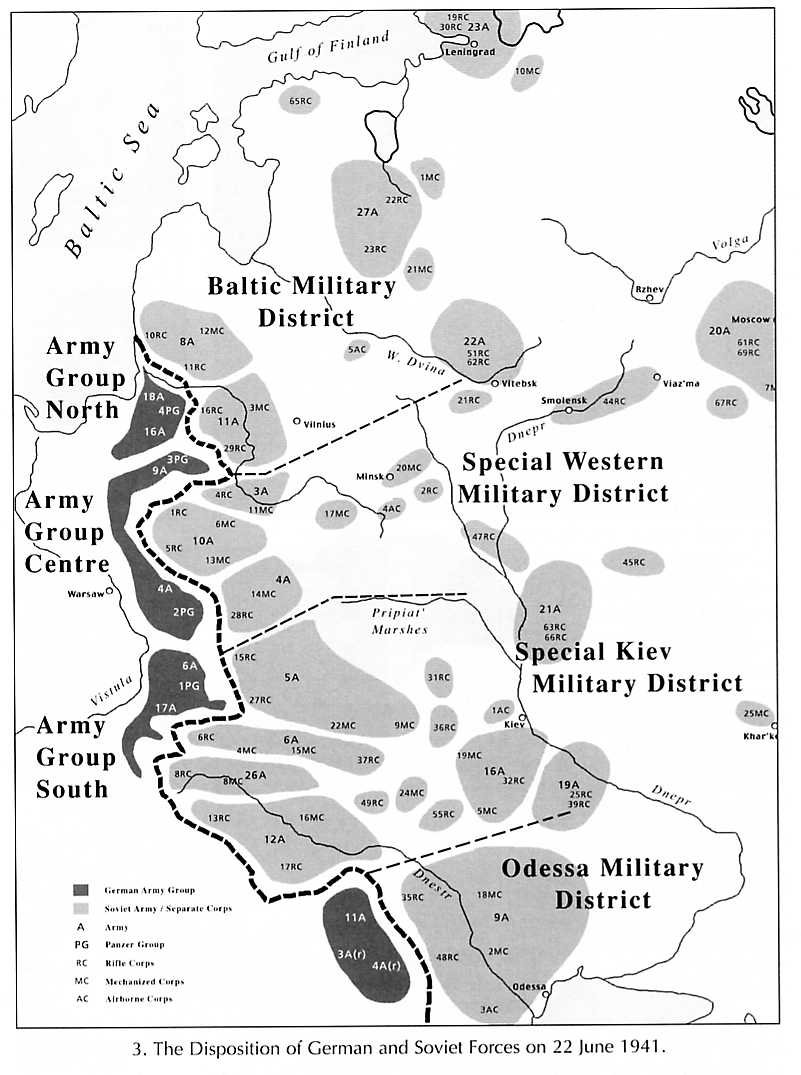
Glantz, David M. Barbarossa: Hitler's Invasion of Russia 1941. Tempus Publishing Inc. Charleston. 2001.
Soviet War Planning: The Answering Strike.

Ironically, the Ribbentrop-Molotov Non-Aggression Pact, which Stalin and Hitler
negotiated in August 1939, actually contributed to the catastrophic defeat the
Red Army suffered during the initial stages of Operation Barbarossa. By signing
the infamous agreement, Stalin hoped to forestall possible German aggression
against the Soviet Union and, while doing so, create a buffer zone by seizing
eastern Poland and the Baltic States. However, the Soviets' subsequent occupation
of eastern Poland in September 1939 and the Baltic States a year later brought
the Soviet Union into direct contact with Germany and forced the Red Army General
Staff to alter its war plans fundamentally. Beginning in July 1940, the Red
Army General Staff developed new war plans identifying Germany as the most dangerous
threat and the region north of the Pripiat' River as the most likely German
attack axis.5 Stalin, however, disagreed with these assumptions and in October
1940 insisted his General Staff prepare a new plan based on the assumption that,
if it attacked, Germany would likely strike south of the Pripiat' River into
the economically vital region of the Ukraine.6 With minor modifications, this
plan became the basis for Mobilization Plan (MP) 41 and associated Red Army
operational war plans.
Ordered by Stalin and prepared in early 1941 by G.K. Zhukov, the new Chief of
the General Staff, State Defence Plan 1941 (DP 41) reflected the assumption
'that the Red Army would begin military operations in response to an aggressive
attack.'7 Therefore, while defensive in a strategic sense, the plan and the
military thought that it echoed was inherently offensive in nature. DP 41 and
its associated mobilization plan required the Red Army to deploy 237 of its
303 divisions in the Baltic Special, Western Special and Kiev Special Military
Districts and the 9th Separate Army, which, when war began, would form the Northwestern,
Western, Southwestern and, ultimately, Southern Fronts.8 As a whole, Red Army
forces in the western Soviet Union were to deploy in two strategic echelons.
The first was to consist of 186 divisions assigned to four operating fronts,
and the second was to include 51 divisions organized into five armies under
High Command (Stavka) control. In turn, the four operating fronts
were to deploy their forces in three successive belts, or operational echelons,
arrayed along and behind the new frontier. The first operational echelon formed
a light covering force along the border, and the second and third echelons,
each of roughly equal size, were to add depth to the defence and conduct counterattacks
and counterstrokes.
Mobilization difficulties in early 1941, however, precluded full implementation
of DP 41. Consequently, on 22 June 1941 the first strategic echelon's three
operational belts consisted of 57, 52 and 62 divisions, respectively, along
with most of the Red Army's 20 mechanized corps deployed in European Russia.9
The five armies deployed in the second strategic echelon under Stavka
control, which ultimately consisted of 57 divisions assembling along the Dnepr
and Dvina rivers, was virtually invisible to German intelligence. Its mission
was to orchestrate a counteroffensive in conjunction with the counterattacks
conducted by the forward fronts. However, by 22 June 1941 neither the forward
military districts nor the five reserve armies had completed deploying in accordance
with the official mobilization and deployment plans.10 As in so many other respects,
the German attack on 22 June caught the Soviets in transition. Worse still,
Soviet war planners had fundamentally misjudged the situation, not only by concentrating
their forces so far forward, but also by expecting the main enemy thrust to
occur south of the Pripiat' Marshes. Thus the Red Army was off-balance and concentrated
in the southwest when the main German mechanized force advanced further north.15
(Glantz 15-16)